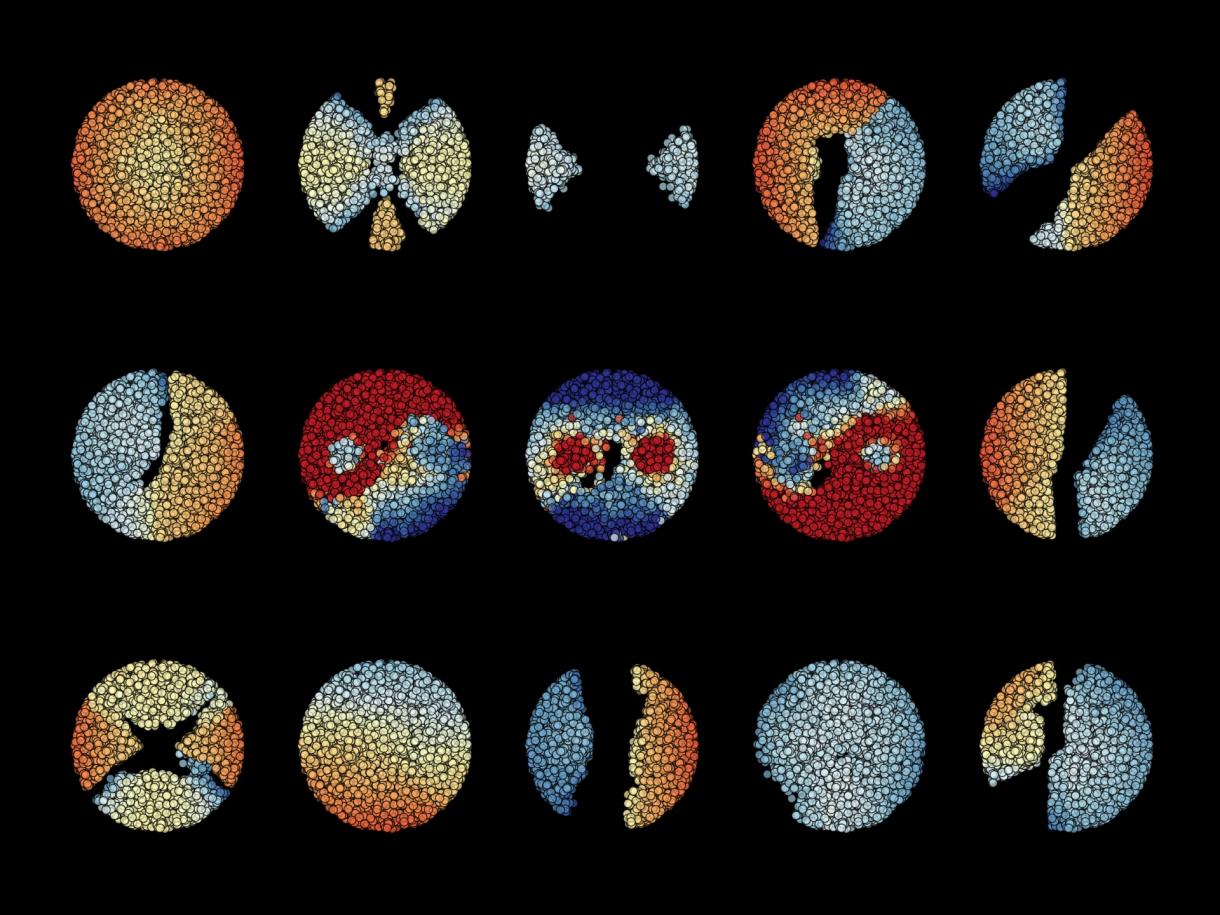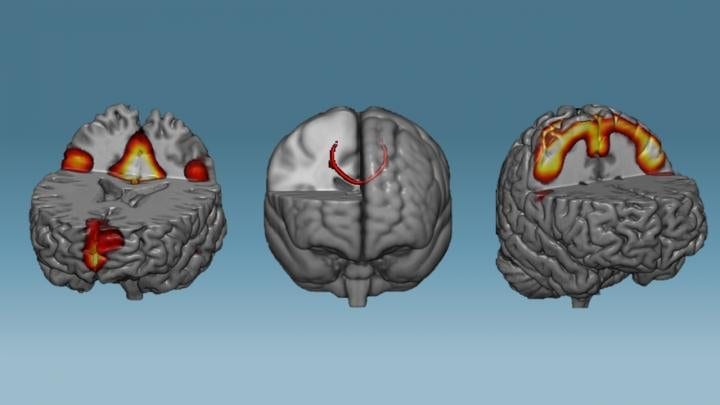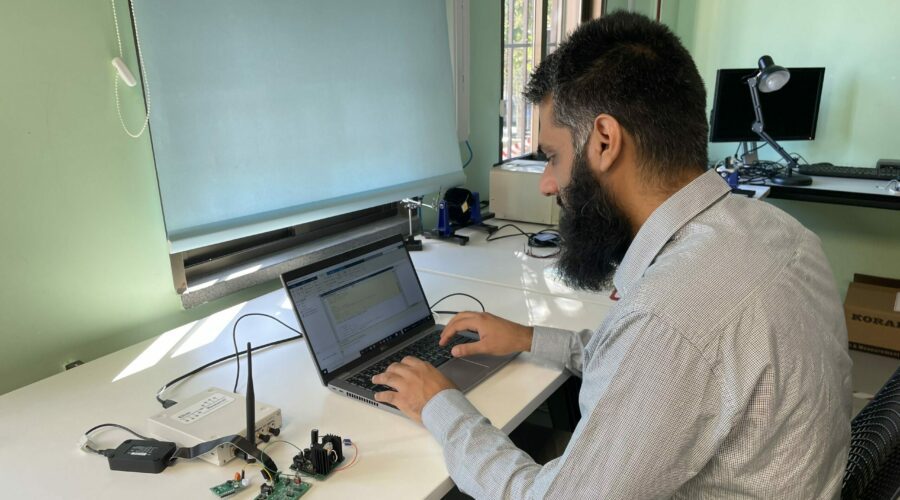
Illustration of the on-chip classification process with the Yin-Yang dataset. Each symbol represents the spike time delay for various classifying neurons.
Credit: Göltz and Kriener et al. (Heidelberg / Bern)
RESEARCHERS FROM HEIDELBERG AND BERN DEVELOP A NEW TRAINING APPROACH FOR SPIKING NEURAL NETWORKS
Developing a machine that processes information as efficiently as the human brain has been a long-standing research goal towards true artificial intelligence. An interdisciplinary research team at Heidelberg University and the University of Bern (Switzerland) led by Dr Mihai Petrovici is tackling this problem with the help of biologically-inspired artificial neural networks.
Spiking neural networks, which mimic the structure and function of a natural nervous system, represent promising candidates because they are powerful, fast, and energy-efficient. One key challenge is how to train such complex systems. The German-Swiss research team has now developed and successfully implemented an algorithm that achieves such training.
The nerve cells (or neurons) in the brain transmit information using short electrical pulses known as spikes. These spikes are triggered when a certain stimulus threshold is exceeded. Both the frequency with which a single neuron produces such spikes and the temporal sequence of the individual spikes are critical for the exchange of information. “The main difference of biological spiking networks to artificial neural networks is that, because they are using spike-based information processing, they can solve complex tasks such as image recognition and classification with extreme energy efficiency,” states Julian Göltz, a doctoral candidate in Dr Petrovici’s research group.
Both the human brain and the architecturally similar artificial spiking neural networks can only perform at their full potential if the individual neurons are properly connected to one another. But how can brain-inspired – that is, neuromorphic – systems be adjusted to process spiking input correctly? “This question is fundamental for the development of powerful artificial networks based on biological models,” stresses Laura Kriener, also a member of Dr Petrovici’s research team. Special algorithms are required to guarantee that the neurons in a spiking neural network fire at the correct time. These algorithms adjust the connections between the neurons so that the network can perform the required task, such as classifying images with high precision.
The team under the direction of Dr Petrovici developed just such an algorithm. “Using this approach, we can train spiking neural networks to code and transmit information exclusively in single spikes. They thereby produce the desired results especially quickly and efficiently,” explains Julian Göltz. Moreover, the researchers succeeded in implementing a neural network trained with this algorithm on a physical platform – the BrainScaleS-2 neuromorphic hardware platform developed at Heidelberg University.
According to the researchers, the BrainScaleS system processes information up to a thousand times faster than the human brain and needs far less energy than conventional computer systems. It is part of the European Human Brain Project, which integrates technologies like neuromorphic computing into an open platform called EBRAINS. “However, our work is not only interesting for neuromorphic computing and biologically inspired hardware. It also acknowledges the demand from the scientific community to transfer so-called Deep Learning approaches to neuroscience and thereby further unveil the secrets of the human brain,” emphasises Dr Petrovici.
Original Article: SOLVING COMPLEX LEARNING TASKS IN BRAIN-INSPIRED COMPUTERS
More from: Heidelberg University | University of Bern
The Latest Updates from Bing News & Google News
Go deeper with Bing News on:
Spiking neural networks
- AlphaFold 3 unlocks a new scientific era, mastering 'all of life's molecules'
Google DeepMind's groundbreaking new AI predicts not only the structure of proteins, ligands, DNA, RNA and "all of life's molecules," but how they'll interact. It promises a radical, revolutionary ...
- Neuromorphic Chip Market Size To Touch $2734.8 Million By 2031 Driven By Industrial Adoption And Big Data Analysis
Neuromorphic chips offer a revolutionary approach to computing by mimicking the human brain's structure and function. These chips leverage spiking neural networks (SNNs) that emulate the biological ...
- Neuromorphic supercomputer SpiNNaker 2 can be rented in the cloud
SpiNNcloud Systems offers access to up to 656,640 economical CPU cores with accelerators that calculate up to 0.3 quintillion operations per second.
- BrainChip Earns Australian Patent for Improved Spiking Neural Network
BrainChip Holdings Ltd (ASX: BRN, OTCQX: BRCHF, ADR: BCHPY), the world’s first commercial producer of ultra-low ...
- Sandia Pushes The Neuromorphic AI Envelope With Hala Point “Supercomputer”
Not many devices in the datacenter have been etched with the Intel 4 process, which is the chip maker’s spin on 7 nanometer extreme ultraviolet immersion ...
Go deeper with Google Headlines on:
Spiking neural networks
[google_news title=”” keyword=”spiking neural networks” num_posts=”5″ blurb_length=”0″ show_thumb=”left”]
Go deeper with Bing News on:
Biologically-inspired artificial neural networks
- Organic electrochemical transistors: Scientists solve chemical mystery at the interface of biology and technology
Researchers who want to bridge the divide between biology and technology spend a lot of time thinking about translating between the two different "languages" of those realms.
- AI Efficiency Breakthrough: How Sound Waves Are Revolutionizing Optical Neural Networks
Researchers have developed a way to use sound waves in optical neural networks, enhancing their ability to process data with high speed and energy efficiency. Optical neural networks may provide the ...
- Nanofluidic memristors compute in brain-inspired logic circuits
This ionic approach is unlike the best artificial neural systems, which use electron currents to mimic these synapses. Building artificial nanofluidic neural networks could provide ... they can mimic ...
- How Neural Concept’s aerodynamic AI is shaping Formula 1
NCS will then dig into its neural network to suggest improvements or ... There is talk of artificial agents on the pit wall calling the shots for race strategy and even car setups.
- Artificial Intelligence ‘Explainability’ Is Overrated
and for characterizing how information flows through the layers of an artificial neural network. Over time, we will gain a clearer picture of how these models process data to arrive at outputs.
Go deeper with Google Headlines on:
Biologically-inspired artificial neural networks
[google_news title=”” keyword=”biologically-inspired artificial neural networks” num_posts=”5″ blurb_length=”0″ show_thumb=”left”]










